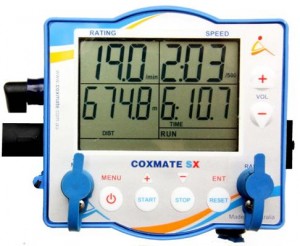Rowperfect UK encourages customers to try out our products before they buy.
We think that the products we sell help athletes and coaches to move boats faster and improve rowing and sculling technique – but it’s important that you find this out for yourself and that’s why we encourage customers to test out our products.
We requested Rory Copus of Oxford Brookes University Boat Club, one of our Coxmate SX customers, to fill in this survey after trying out the demonstration before he bought the product.
Which product(s) did you try?
Coxmate SX
What comparable equipment do you usually use?
None
How long / how many outings did you do?
5 outings, each 2 hours long. Fours Head was considered an outing, to allow testing in a race situation.
What were your first impressions?
Obviously it doesn’t instantly fit into the standard coxbox cups, but upon the provision of a magnetic foam mount, the problem was gone. The cup itself is easy to fit and strong magnetically. The display is also clear, as each set of data values is separated from the rest. (But I personally believe a dot matrix display would be a lot clearer than a bar matrix).
When you did your first outing was it easy to use? And if it was not easy, what did you find hard or not intuitive?
Upon reading the instructions, it was easy to use. The button layout is a lot clearer than previous models, and works effectively. The GPS connects quickly when the unit is turned on, and the menu is relatively easy to navigate, so long as you know what you are looking for.
When I first turned on the unit, it displayed RdY (ready to go), which to me looked like Rd4, leading me to believe something was wrong. I had to look at the instructions quickly to assure myself it was telling me it was ready to start!
I like it how the volume buttons are laid out on the side, so they don’t get confused with the other command buttons. Everything is labeled clearly in different colours. Even though the box is not circular, it is much more aesthetically pleasing than the previous rectangular Coxmates that looked quite garish and clunky. The manufacturing itself also seems ‘cleaner’.
Did you do any tests to compare to your previous equipment? And what did the tests show?
There seemed to be no difference is sound quality between a Coxmate and an NK, as both maintain their clarity at higher volumes. One thing I noticed is the Coxmate microphone was only a little more sensitive to the “S” sound, and a little bit of wind – but it wasn’t a concern at all, just an observation.
The GPS function was very useful. It gives out the same data readings as an impeller would (assuming you’re rowing on a flat lake), but the attraction of no set-up time, and instant data values is preferable. I like the way the timer has three ways of starting – double tap to go, tap and wait for the stroke’s seat sensor, or push and hold for a 10second countdown timer. I have used the Coxmate PC analysis software constantly since getting the Coxmate. It is a massively useful visual aid for seeing a crew’s consistency, and seeing how effective they were at letting the boat work for them.
What did the coach think?
It was very useful for post-race analysis (if used in a race situation). It is also very effective in looking at a crew’s efficiency and speed when paddling, or doing pieces in preparation for races. The idea of GPS is a lot more effective on a flat lake, but it does give the ability to find the fastest piece of water during pre-race training sessions. It is an asset experienced coxes can use to great effect. The GPS function may be too much for less experienced/novice coxes to use to any extent.
What did the athletes / cox think?
The athletes enjoyed hearing the splits generated with the GPS, and being able to use that as a marker when doing pieces. It helped maintain pace during pieces, and aim for a certain level. The cox found the Coxmate SX coxbox a great asset. It allowed them to monitor the crews’ consistency whether paddling or racing, and allowed them to verbally relay this to the crew. The rates were also helpful, as it gives a greater resolution to the stroke rate than just ½. By displaying the rate to 0.1, it gives a greater idea of how controlled the crew is at maintain rate and rhythm.
Anything else you want to tell us that could help us improve our service or product range?
The battery %-age indicator has always been a bit iffy with Coxmates for me. It is always slightly inaccurate, to differing extents. With my experience of using the Coxmate, across 6 Coxmates from 3 different models, there was only one that had no issues with displaying the correct battery percentage. Although I charge the coxbox at the end of every day’s usage, which causes no problem of battery loss, I would still like to know what the actual values are. I’d also like to see the Analysis Software available for Macintosh. I work primarily off a Mac, and to use the software, I had to find a PC to use.






